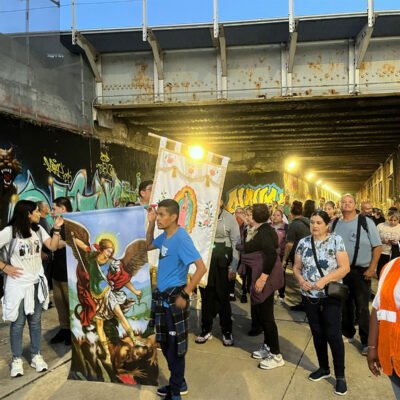(RNS) — On Nov. 14, almost 300,000 American Jews (including my three children) and their allies came to speak out in support of Jewish lives in Washington, one of the largest rallies of its kind.
In New York that same evening, I attended the premiere of a show devoted to songs of the Holocaust at the Museum of Jewish Heritage in Battery Park. As the cast of 10 raised their voices, the juxtaposition of the two events provoked in me a question: Almost 80 years after the end of World War II, with Jewish lives again under threat in Israel and antisemitism rising around the world, what does it mean to have the ability to speak out at this moment?
In Washington, the rally felt like a salve for the pain of hate that many Jews had been feeling, particularly on college campuses like the one where my youngest daughter has just matriculated. We were together with so many who care deeply that our perspectives are heard. It gave a huge lift to those who were there, from Los Angeles, Houston, Minneapolis, Detroit and closer by, undeterred by long distances and hours of travel.
Eighty years ago, two days before Yom Kippur in 1943, a group of 400 Haredi rabbis marched to the White House, one of the few times Jews spoke out about what was happening to Jews in Europe. One Jewish member of Congress wanted the march called off because it was “undignified.” A prominent Reform rabbi concurred. President Franklin Roosevelt slipped out of the White House rather than meet with the delegation. (His snub made the news, however, and led to the formation of the War Refugee Board.)
In light of this history, it makes sense that in the current moment Jews of all minds — those who are inclined to call for a cease-fire and those who want to see Hamas forcibly removed — would gather simply to stand up for Israel and for Jewish determination to endure together.
I had long before made plans to see the premiere of “Amid Falling Walls,” a “multimedia musical journey” presented by the National Yiddish Theatre Folksbiene at the Museum of Jewish Heritage. The 27 songs, sung in Yiddish, were written between 1939 and 1945 in the ghettos of Warsaw, Vilna, Lodz, Krakow and Bochnia and in concentration camps, partisan encampments and forests. Many of them were originally collected in 1948 by the Polish musician and poet Shmerke Kaczerginski as “Lider Fun di Getos un Lagern” (“Songs of the Ghettos and Camps”).
They lend an understanding of how the Jews who experienced the Holocaust processed the catastrophe, but in the current moment their themes also quietly captured the cycles of Jewish history and, again, how the Jews have endured. As the show’s writer, Avram Mlotek, wrote in his program notes, the show is “a joyous reminder that we have outlived and will continue to outlive those who seek our undoing.”

The Company of “Amid Falling Walls” at the Museum of Jewish Heritage. (Photo © Jeremy Daniel)
The Hamas attack on southern Israel, which came two days before rehearsals began on Oct. 9, made the songs “more meaningful than they have been,” Abby Goldfarb, one of the performers, told me after the premiere. Another singer, Eli Mayer, who has family in Israel, said the show helped him cope with the situation, and his castmate Jacob Ben-Shmuel said that as rehearsals got underway he had felt “privileged to be unaware” of the reality the show depicts, but that the performers “don’t have that privilege” after Oct. 7.
The show’s creator and musical arranger, Zalmen Mlotek, said in a phone interview a few days after it opened, “I have been performing this music all my life but never created a theatrical set for it.” He had learned of many of the songs from his mother, Chana, who with her sister, Malke Gottlieb, had collected some of the songs in the show in a 1983 book, “We are Here: Songs of the Holocaust.” He had heard the actuality behind them from his father, Yosl, who survived World War II in Vilna, Poland, then was fortunate to be granted passage out of Europe by the Japanese diplomat Chiune Sugihara, who secured freedom for many Jews during the war. Yosl went to Kobe in Japan and then Shanghai.
The show, Mlotek said, is part of his lifelong effort to transmit the heritage of Yiddish song so important to both his parents. “Because of the sensitivity of the material,” he said, he didn’t want to fabricate a story to pull the songs together — a Holocaust jukebox musical. They are accompanied instead with a montage of pictures and video of Jewish life in Europe.
“I wanted the songs to be living testimony, actual documents that illuminate in a historical and factual way, deeply emotional, and creative, how Jews lived and survived,” Mlotek said.
The timing of the Hamas attack justified his decision. “At this point in Jewish history, we are singing songs about the right for Jews to live as Jews, to fight back and to do whatever is necessary to be able to live.”
The songs, he said, enable the audience to “learn how people reacted, and what they did, how they came together and how they functioned … under the worst possible conditions, worst possible terror.” The songs exist “for people to take it in, to get stronger, to be comforted, to be inspired by it.”
The songs performed this function in various ways, but their defiance is evident, as in the Warsaw ghetto cabaret tune “Shoyn Genug” (“Enough Already”) and the best-known song, the partisan hymn “Zog Nit Keynmol” (“Never Again”), composed by Hirsh Glik on hearing about the 1943 Warsaw Ghetto uprising, brutally crushed by German troops after the ghetto’s inhabitants resisted deportation.
The notes on the songs in the program were made by Bret Werb, who is a staff musicologist at the United States Holocaust Memorial Museum in Washington, and the songs themselves are all online at The Workers Circle archive. But with all the resonance of the current moment, I wished, watching the montages go by, that the show had told more about how these particular songs fit into the larger backdrop of the world in which they were composed.
“Yiddish song allows us to focus on how Jews lived and created,” Avram Mlotek — who is Zalmen’s son — wrote in The Wall Street Journal. I wanted to know more about how they did so, and what it meant to their time. Hearing their voices mingled with those on the streets of Washington gave me hope. The cycles of Jewish history, despair and uplift continue. When we learn how Jews in the past expressed themselves, we know that present-day and future Jews will also be able to endure.
(Beth Kissileff, co-editor of “Bound in the Bond of Life: Pittsburgh Writers Reflect on the Tree of Life Tragedy,” is a writer in Pittsburgh. The views expressed in this commentary do not necessarily reflect those of Religion News Service.)



